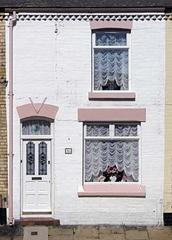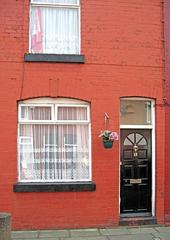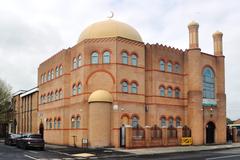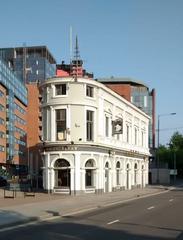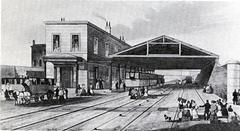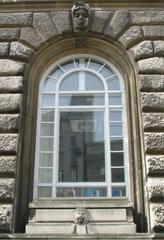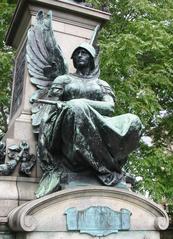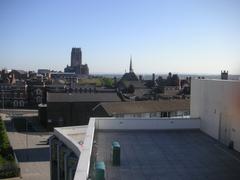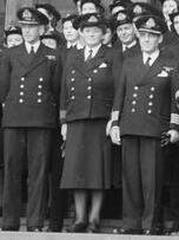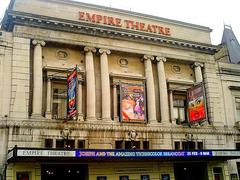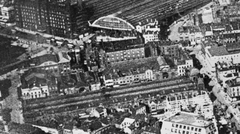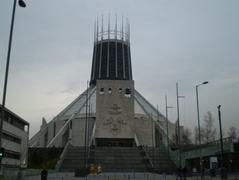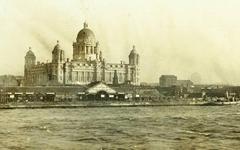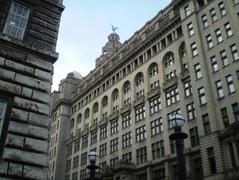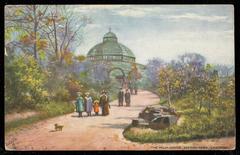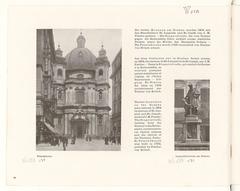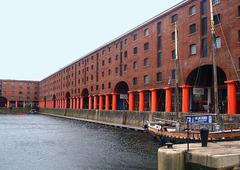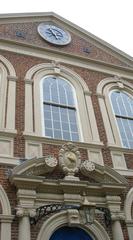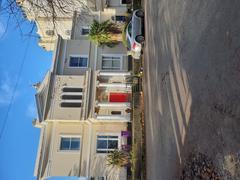Castle Moat House Liverpool: Visiting Hours, Tickets, and Comprehensive Travel Guide
Date: 03/07/2025
Introduction
Castle Moat House, standing on Fenwick Street in Liverpool’s historic city center, is a remarkable testament to the city’s layered past. From its medieval origins atop the moat of Liverpool Castle to its 19th-century neoclassical incarnation as a banking headquarters, and through to the modernist hotel era and the Liverpool ONE development, the site has continually evolved alongside Liverpool itself. This guide provides visitors with an in-depth look at the architectural, historical, and cultural significance of Castle Moat House, alongside practical information for exploring the site and its vibrant surroundings (Liverpool Echo; The Guide Liverpool; Visit Liverpool).
Table of Contents
- Historical Overview
- Architectural Significance
- Urban Evolution: From Castle to Modern City
- Visiting Information
- Nearby Attractions
- Events and Seasonal Highlights
- Practical Visitor Tips
- Frequently Asked Questions (FAQ)
- Visuals and Media
- References and Further Reading
- Conclusion and Call to Action
Historical Overview
Medieval Foundations
The origins of Castle Moat House are inseparable from Liverpool Castle, a defensive fortress built in the 1230s under King John to protect the burgeoning port (The Guide Liverpool). The castle’s moat, hewn from solid rock, provided formidable protection and shaped the local topography for centuries.
After the castle’s demolition in the early 18th century—mandated by Parliament and replaced by St. George’s Church—the site underwent repeated transformations, eventually becoming home to the Victoria Monument in 1902. While none of the original castle survives above ground, the area’s layout and place names (Castle Street, Paradise Street) preserve its memory.
19th-Century Banking Hub
In the Victorian era, Liverpool became a global trading powerhouse, and Castle Moat House rose as the headquarters of the North and South Wales Bank. Designed by Edward Corbett and constructed between 1838 and 1840, the building exemplifies early Victorian neoclassical architecture, characterized by slender Corinthian columns and a dignified stone façade. Its foundations are believed to rest atop the original castle moat, forging a physical link between the medieval past and the financial ambitions of 19th-century Liverpool (Liverpool Echo).
Adaptive Reuse and Modern Developments
As traditional banking declined, Castle Moat House, along with many neighboring historic buildings, was adapted for new uses—offices, restaurants, and serviced apartments—preserving its heritage while keeping pace with Liverpool’s urban renewal. The later addition of the modernist Castle Moat House hotel on Paradise Street signaled Liverpool’s post-war transformation, until the hotel’s demolition in 2005 paved the way for the Liverpool ONE development (Liverpool Echo).
Architectural Significance
Castle Moat House stands as a fine example of neoclassical design, with a symmetrical façade, Corinthian-inspired columns, and classical detailing that convey stability and prestige. Its Grade II listed status ensures ongoing protection, recognizing its role as a key component of one of the UK’s densest clusters of heritage buildings (Liverpool Echo).
The building’s architectural restraint contrasts with the more ornate banks nearby, enriching Liverpool’s historic streetscape. Today, it remains a landmark for architecture enthusiasts and a focal point for heritage walking tours.
Urban Evolution: From Castle to Modern City
The story of Castle Moat House mirrors Liverpool’s transformation from a medieval stronghold to a commercial metropolis and, later, a hub for tourism and culture. The site’s journey—from castle, to church, to monument, to bank, to modern hotel, and finally to a centerpiece of Liverpool ONE—reflects the city’s resilience and capacity for renewal.
The demolition of the modernist Castle Moat House hotel and the creation of Liverpool ONE marked a decisive shift toward urban regeneration, pedestrian-friendly spaces, and cultural vibrancy (Liverpool Echo; Liverpool ONE).
Visiting Information
Current Status
- Castle Moat House (Fenwick Street): The historic building is primarily used as commercial offices. While it does not operate as a public museum, its exterior can be viewed and appreciated at any time.
- Liverpool ONE (Paradise Street): The former hotel site is now a major shopping, dining, and leisure destination, fully accessible to the public.
Opening Hours
- Castle Moat House (Exterior): Viewable at any time.
- Liverpool ONE: Open daily; hours vary by retailer and venue. Consult Liverpool ONE for up-to-date times.
Entry Fees
- No general admission fees for viewing the Castle Moat House exterior or accessing Liverpool ONE. Guided tours of the financial district or heritage sites may require booking and a fee.
Accessibility
- Both the Fenwick Street and Liverpool ONE sites are accessible by public transport and offer step-free access. For interior access or special needs, check with individual venues or tour operators.
Getting There
- By Train: Liverpool Lime Street and James Street stations are within walking distance.
- By Bus: City center routes serve Fenwick Street and Liverpool ONE.
- By Car: Several public car parks are nearby, though spaces can fill during peak times.
Nearby Attractions
- Victoria Monument: Marks the original location of Liverpool Castle.
- Royal Albert Dock: Home to museums, galleries, shops, and restaurants (Visit Liverpool).
- Museum of Liverpool: Explores the city’s maritime and social history.
- The Beatles Story: Celebrates the legacy of Liverpool’s iconic band.
- Bank of England Building and Martins Bank: Other notable heritage sites in the financial district.
Events and Seasonal Highlights
Liverpool’s events calendar is lively year-round. July 2025 features:
- Heritage walking tours
- Outdoor concerts and tribute festivals
- The Beatles-themed events
- Art exhibitions and immersive experiences
For schedules and tickets, consult local tourism sites and event listings (All Events in Liverpool).
Practical Visitor Tips
- Plan Ahead: Book tours and accommodation in advance, especially during festivals and summer holidays.
- Weather: Pack for changeable weather; July is typically mild but can be rainy.
- Transport: Liverpool’s city center is walkable; public transport is reliable.
- Accessibility: Confirm accessibility needs with venues and tour operators.
- Etiquette: Respect heritage sites and public spaces; Liverpool’s locals are renowned for their friendliness.
Frequently Asked Questions (FAQ)
Q: Can I go inside Castle Moat House?
A: Interior access is limited as the building serves commercial purposes. Guided tours may occasionally include entry; check with local operators.
Q: Is there an entry fee?
A: No fee for viewing the exterior. Some heritage tours require a ticket.
Q: Is the site wheelchair accessible?
A: Both the building’s exterior area and Liverpool ONE are accessible.
Q: What are the best times to visit?
A: Spring and summer offer pleasant weather and vibrant city events.
Q: Are there guided tours?
A: Yes, several walking tours of Liverpool’s historic district include Castle Moat House as a highlight.
Visuals and Media
- Image: Castle Moat House’s neoclassical façade (alt=“Castle Moat House Liverpool neoclassical façade”)
- Map: Location of Castle Moat House and Liverpool ONE (alt=“Map showing Castle Moat House and Liverpool ONE in Liverpool city center”)
- Archival photos: Available through Liverpool Echo archives and local libraries.
References and Further Reading
- The Guide Liverpool – History and Fate of Liverpool Castle
- Liverpool Echo – Famous Bank Buildings
- Liverpool Echo – Vanished City Centre Hotel
- Visit Liverpool – Official Tourism Site
- Liverpool ONE – Shopping and Leisure
- Moat House Hotel Liverpool
- Liverpool City Region Visitor Guide
- All Events in Liverpool July 2025
Conclusion and Call to Action
Castle Moat House stands as a testament to Liverpool’s enduring spirit, bridging medieval origins, Victorian ambition, and modern vitality. Whether you’re an architecture buff, history lover, or casual visitor, the site and its surroundings promise a rich, engaging experience. Plan your visit, explore Liverpool’s historic heart, and be part of its ongoing story.
For the latest updates, download the Audiala app, browse related heritage articles, and follow us on social media for news on upcoming tours and events.
